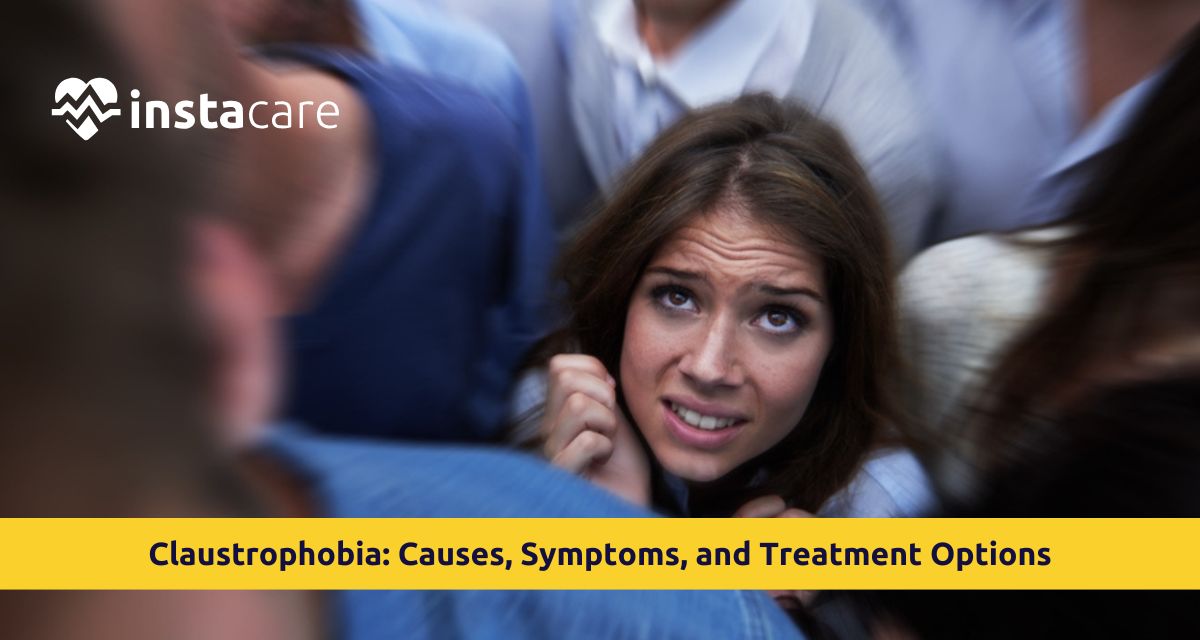What is Claustrophobia?
Claustrophobia is a self-contained phobia wherein the patient has a rational, pathological fear of being trapped or becoming confined within an enclosed area. For such patients, mundane situations like traveling on an elevator, making a journey within a tunnel, or attending an MRI session are perilous and cause fear.
It can cause a great deal of distress and anxiety and interfere with one's lifestyle, career, social life, and health. Claustrophobia can be treated and even eliminated with proper education and treatment.
Essential Aspects About Claustrophobia
Claustrophobia is a phobic disorder which typically develops either in childhood or adolescence. It will persist in adult life and increase with age only if it is not treated.
This is not just fear; it is physical and emotional response to the sensation of being trapped or trapped. The victim becomes anxious by merely considering such scenarios.
The fear does not have to be room-based. Anything in which an individual feels trapped and cannot escape might induce claustrophobia, such as packed trains, basements, airplanes, or even toilet stalls with automatic doors.
What Triggers Claustrophobia?
Triggers vary from person to person. Someone may fear being physically stuck, but someone else would fear being unable to breathe or losing control when the room is shut.
In almost all cases, the space is not phobic but rather the feared result of being helpless, trapped, or out of control. As an example, someone may refuse to use an elevator not because of its height but because he/she fears the elevator will fail and he/she will be stuck.
Past trauma, conditioned response, or generalized
anxiety sensitivity is likely the cause here. A child once locked in a tiny closet can create an association between small rooms and fear that cannot be reversed. Witnessing another person respond with fear in a small room is bound to cause the condition.
Physical and Emotional Symptoms
- Claustrophobia is mind and body influencing. Symptoms are anything from very minor to severe panic attacks.
- Physically, one might also experience symptoms such as sweatiness, breathlessness, tremble, racing heart, nausea, dizziness, and pain or constriction feeling in the chest. Some people have reported choking or feeling choked.
- Emotionally, it is most commonly followed by a feeling of horror, fear of losing control, or wanting to escape. Individuals become highly conscious of the environment and are obsessed with escape strategies. These may be displayed even when the individual intellectually knows that they are not in danger.
- Over time, fear of being in confined spaces can create neurotic anxiety, and everyday activities become hard to achieve.
The Daily Impact of Claustrophobia
Claustrophobia is not a transient fear to others, it controls their life. They will miss work interviews in tall buildings, refuse travel invitations, or fail to visit the doctor with scans or tiny examination rooms.
This avoidance will cause lost opportunities and social isolation. The fear becomes general soon enough, establishing new avoidance and tension overall.
Most individuals start developing habits for the avoidance of any situation that would bring them in contact with their claustrophobia, again restricting their life and interfering with social relationships. The longer the disease goes without being treated, the more deeply these phobias and habits will be rooted.
Panic-Arousing Real-Life Situation
Claustrophobia can arise in an unlimited variety of situations of everyday life. It is not just a matter of clearly closed-in spaces. Below are some of the most common situations that will be appalling:
- Riding on a busy elevator
- Riding on a busy airplane
- Riding on the subway at rush hour
- Having an MRI or CT scan
- Being forced into a tight, windowless room
- Stranded in a traffic jam in a tunnel
Outdoor spaces can even become claustrophobic when the person perceives that there is no quick way out.
Diagnosis of Claustrophobia
The psychological expert diagnoses claustrophobia via interview and psychological testing. The diagnostic features are the existence of increased and recurrent fear for over six months and affecting the individual's functioning in life. The expert also assesses if the phobia is typical of a generalized anxiety disorder or associated with some other mental disorder like depression or PTSD.
A proper diagnosis is of critical importance since treatment processes may vary depending on the patient's background, history, and emotional stimulus.
Effective Treatment Processes
No such cure exists, but numerous therapy processes have been found very effective in curing and alleviating symptoms of claustrophobia.
- Cognitive Behavioral Therapy (CBT) would be most commonly the treatment of preference. This methodical form of therapy educates individuals about how their behavior, emotions, and thoughts are related. Through CBT, individuals can rid themselves of irrational fears and substitute them with positive patterns of thinking.
- Exposure is a technique that has been consistently used. Systematic and controlled exposure to the source or situation of fear is done in a way that will allow the individual to become familiar with it and be desensitized. To fantasize about being in a small room, to advancing towards picture exposure, to being in an actual small room under supervision is the way this may be initiated.
- Medication may also be applied in some cases to treat symptoms, especially where the treatment itself is not adequately relieving. Amongst some of the most commonly prescribed medication are:
{SSRIs (Selective Serotonin Reuptake Inhibitors), Anti-anxiety medication (short-term),Beta-blockers (for the control of body symptoms like tremors)}
- Mindfulness techniques like meditation, controlled breathing, and progressive muscle relaxation also work effectively in keeping a person calm even when anxious.
In later times, too, virtual reality therapy has proved to be quite a force to be reckoned with, allowing patients to confront precipitating surroundings in a safe, virtual space, reducing fear through repeated exposure.
Self-Management and Lifestyle Tips
While therapy is the most crucial in the cure of claustrophobia, there are self-help methods to allow one to heal. They allow one to deal with their anxiety and restrict themselves from exposure by such triggering environments.
Self-help suggestions include:
- Deep breathing exercises during work with stressful environments
- Positive affirmations for reframing negative thoughts
- Visualization of peaceful environments
- Psychological preparation of certain causes before exposure
- Grounding activities, such as the use of body environments to stay grounded
These can prove helpful in minimizing the emotional and physical effects of claustrophobic rooms, particularly when done regularly.
How Can You Help a Loved One who Suffers from Claustrophobia?
If your loved one is claustrophobic, supporting him or her can be a great help.
- Listen to them without criticism and let them know that the fear is legitimate even when the situation looks harmless to you. Don't try to push them beyond their fears too fast. Rather, offer small steps, reinforce successes, and suggest professional assistance when needed.
- Be patient. Phobias are conquered in the long run, and the process is one where there are setbacks. Your patience and perseverance might encourage them to have the confidence to conquer their fear gradually.
Conclusion
Claustrophobia is disabling, but it's a manageable and curable disease. Understanding the causes, tracking the symptoms, and knowing effective treatment protocols are the path to a better life. With therapy, self-treatment, or counseling, the ability to take back control of anxieties and create better lives is accessible. Persistence, time, and an understanding guide render overcoming claustrophobia easily attainable.
Please book an appointment with the
best Psychologist in Lahore, Karachi, Islamabad, and all major cities of Pakistan through
InstaCare, or call our helpline at 03171777509 to find the verified doctor for your disease.

